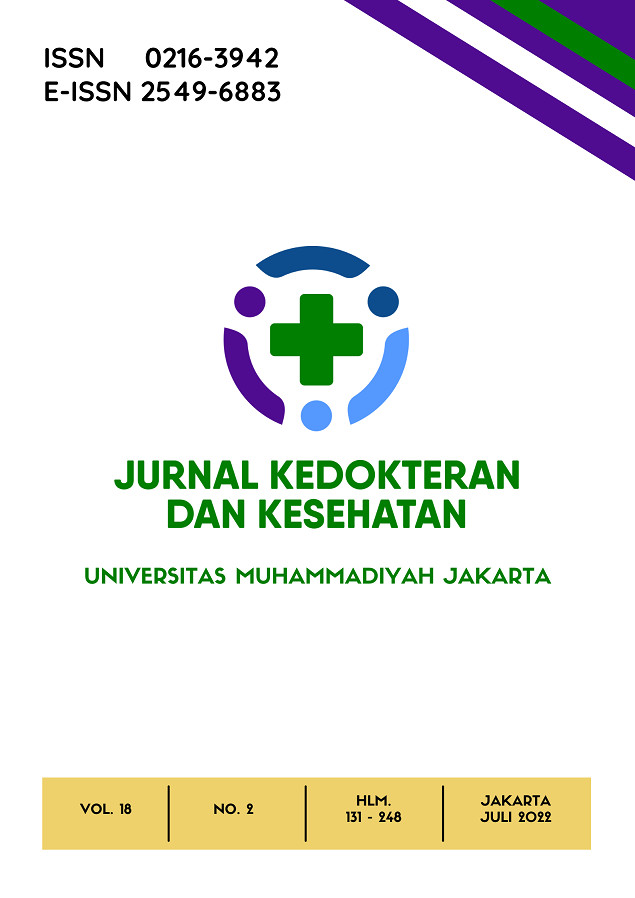Analisis Spasial Pandemi COVID-19 di Jawa Timur (Januari – Juli Tahun 2021)
DOI:
https://doi.org/10.24853/jkk.18.2.164-176Keywords:
analisis spasial, COVID-19, ppkm, jawa timurAbstract
WHO menetapkan wabah COVID-19 sebagai pandemi global. Jawa Timur menjadi salah satu wilayah yang mengalami peningkatan kasus COVID-19. Penelitian ini menampilkan pola penyebaran spasial di wilayah Jawa Timur serta akan membandingkan kondisi autokorelasi spasial pada periode PPKM dengan statistik pengukuran yaitu Indeks Moran, LISA serta menggunakan pembobotan Queen Contiguity. Hasil penelitian didapatkan selama periode PPKM berlangsung, terdapat autokorelasi spasial insiden COVID-19 di Jawa Timur dengan pola pengelompokan berkembang menjadi cold spot yang terkonsentrasi pada pulau Madura, Jawa Timur bagian utara dan selatan. Serta ditemukan hot spot pada Jawa Timur bagian barat selama periode PPKM mikro. Faktor penentu yang berkaitan dengan pola insiden COVID-19 di Jawa Timur adalah kepadatan penduduk dan tingkat pengangguran terbuka. Ditemukan pula hubungan yang tidak konsisten pada variabel persentase penduduk lansia dan persentase penduduk miskin terhadap insiden COVID-19. Adanya temuan tersebut harus menjadi pertimbangan secara hati-hati dalam pembuatan kebijakan. Oleh karenanya dari temuan ini diharapkan dapat memandu respon kesehatan khususnya di Jawa Timur dalam pengendalian COVID-19.References
Dong M, Zhang J, Ma X, Tan J, Chen L, Liu S, et al. ACE2, TMPRSS2 distribution and extrapulmonary organ injury in patients with COVID-19. Biomed Pharmacother. 2020;131(June):110678.
Liu K, Fang Y-Y, Deng Y, Liu W, Wang M-F, Ma J-P, et al. Clinical characteristics of novel coronavirus cases in tertiary hospitals in Hubei Province. Chin Med J (Engl). 2020;133(9).
Luo S, Zhang X, Xu H. Don’t Overlook Digestive Symptoms in Patients With 2019 Novel Coronavirus Disease (COVID-19). Clin Gastroenterol Hepatol. 2020;18(7):1636–7.
BPS Provinsi Jatim. Perilaku Masyarakat Jawa Timur Pada Masa PPKM Darurat. Jatim; 2021.
Kasus COVID-19 Baru di Jatim Tembus 945 | Dinas Komunikasi dan Informatika Provinsi Jawa Timur.
Huang X et al. Spatial Characteristics of Coronavirus Disease 2019 and Their Possible Relationship With Environmental and Meteorological Factors in Hubei Province , China GeoHealth. 2021;
Li H, Li H, Ding Z, Hu Z, Chen F, Wang K, et al. Spatial statistical analysis of Coronavirus Disease 2019 ( COVID-19 ) in China. 2020;15.
Castro RR, Santos RSC, Sousa GJB, Pinheiro YT, Martins RRIM, Pereira MLD, et al. Spatial dynamics of the COVID-19 pandemic in Brazil. Epidemiol Infect. 2021 Feb;149(60):1–9.
Lee, J. dan Wong DWS (2001). Statistical Analysis with Arcview GIS. New York: John Wiley and Sons; 2001.
Monteiro LD, Martins-Melo FR, Brito AL, Alencar CH, Heukelbach J. Spatial patterns of leprosy in a hyperendemic state in Northern Brazil, 2001-2012. Rev Saude Publica. 2015;49.
Menteri Dalam Negeri RI. Instruksi Menteri Dalam Negeri Nomor 2 Tahun 2021. 2021.
Ren H, Zhao L, Zhang A, Song L, Liao Y, Lu W, et al. Early Forecasting of The Potential Risk Zones of COVID-19 in China’s Megacities. Sci Total Environ. 2020;729:1–9.
Ghiffari RA. Dampak Populasi dan Mobilitas Perkotaan Terhadap Penyebaran Pandemi COVID-19 di Jakarta. J Tunas Geogr. 2020;09(01):81–8.
Menteri Dalam Negeri RI. Intruksi Menteri Dalam Negeri Nomor 3 Tahun 2021. 2021.
Dominicis L De, Arbia G, Groot HLF De, Dominicis L De, Arbia G, Groot HLF De, et al. Concentration of Manufacturing and Service Sector Activities in Italy : Accounting for Spatial Dependence and Firm Size Distribution Concentration of Manufacturing and Service Sector Activities in Italy : Accounting for Spatial Dependence and Firm Size Di. 2013;3404.
Menteri Dalam Negeri RI. Instruksi Menteri Dalam Negeri Nomor 15 Tahun 2021. 2021;
Mukherjee K. COVID-19 and lockdown: Insights from Mumbai. Indian J Public Health. 2020 Jun;64(6):168–71.
Tang Y, Wang S. Mathematic modeling of COVID-19 in the United States. Vol. 9, Emerging microbes & infections. 2020. p. 827–9.
Ahasan R, Alam S, Chakraborty T, Hossain M. Applications of GIS and geospatial analyses in COVID-19 research : A systematic review (version 1 ; peer review : awaiting peer review). 2021;9(1379):1–14.
Scarpone C, Brinkmann ST, Große T, Sonnenwald D, Fuchs M, Walker BB. A multimethod approach for county ‑ scale geospatial analysis of emerging infectious diseases : a cross ‑ sectional case study of COVID ‑ 19 incidence in Germany. Int J Health Geogr. 2020;1–18.
Zhang CH. Spatial Disparities in Coronavirus Incidence and Mortality in the United States : An Ecological Analysis as of May 2020. 2020;36(May):433–45.
Khalatbari-Soltani S, Cumming RC, Delpierre C, Kelly-Irving M. Importance of collecting data on socioeconomic determinants from the early stage of the COVID-19 outbreak onwards. J Epidemiol Community Health. 2020 Aug;74(8):620–3.
Borjas GJ. Demographic Determinants of Testing Incidence and COVID-19 Infections in New York City Neighborhoods. Institute of Labor Economics (IZA); 2020.
Downloads
Published
Issue
Section
License
The copyright of the article fully belongs to the Jurnal Kedokteran dan Kesehatan and publishing rights belong entirely to Faculty of Public Health, Universitas Muhammadiyah Jakarta
Jurnal Kedokteran dan Kesehatan is licensed under a Creative Commons Attribution-NonCommercial 4.0 International License.

